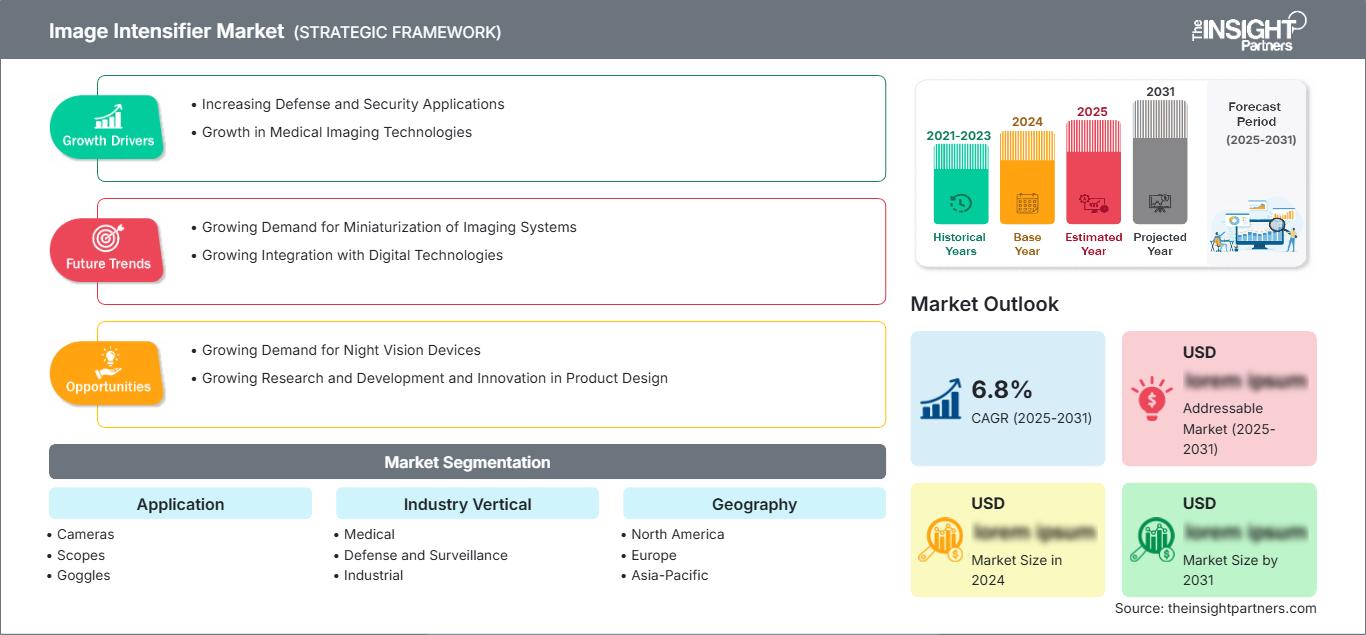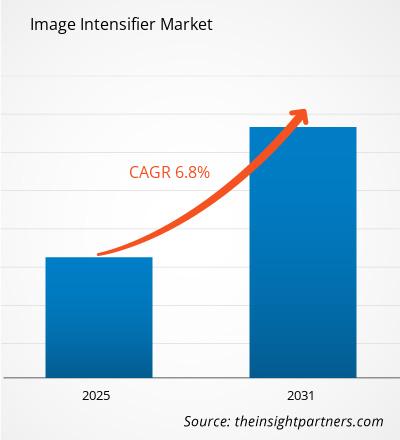Si prevede che il mercato degli intensificatori di immagine registrerà un CAGR del 6,8% dal 2025 al 2031, con una dimensione del mercato in espansione da XX milioni di dollari nel 2024 a XX milioni di dollari entro il 2031.
Il rapporto è segmentato per applicazione (telecamere, oscilloscopi, occhiali, rilevatori di raggi X) e settore verticale (medicina, difesa e sorveglianza, industria, altri). L'analisi globale è ulteriormente suddivisa a livello regionale e per i principali paesi. Il rapporto offre il valore in USD per l'analisi e i segmenti sopra indicati.
Scopo del rapporto
Il rapporto "Image Intensifier Market" di The Insight Partners mira a descrivere il panorama attuale e la crescita futura, i principali fattori trainanti, le sfide e le opportunità. Ciò fornirà spunti a vari stakeholder aziendali, come:
- Fornitori/produttori di tecnologia: per comprendere le dinamiche di mercato in evoluzione e conoscere le potenziali opportunità di crescita, consentendo loro di prendere decisioni strategiche informate.
- Investitori: per condurre un'analisi completa delle tendenze in merito al tasso di crescita del mercato, alle proiezioni finanziarie del mercato e alle opportunità esistenti lungo la catena del valore.
- Organismi di regolamentazione: per regolamentare le politiche e le attività di controllo nel mercato con l'obiettivo di ridurre al minimo gli abusi, preservare la fiducia degli investitori e sostenere l'integrità e la stabilità del mercato.
Segmentazione del mercato degli intensificatori di immagine
- Telecamere
- Oscilloscopi
- Occhiali
- Rilevatori di raggi X
Settore verticale
- Medico
- Difesa e sorveglianza
- Industriale
- Altro
Potrai personalizzare gratuitamente qualsiasi rapporto, comprese parti di questo rapporto, o analisi a livello di paese, pacchetto dati Excel, oltre a usufruire di grandi offerte e sconti per start-up e università
Mercato degli intensificatori di immagine: Approfondimenti strategici

-
Ottieni le principali tendenze chiave del mercato di questo rapporto.Questo campione GRATUITO includerà l'analisi dei dati, che vanno dalle tendenze di mercato alle stime e alle previsioni.
Fattori di crescita del mercato degli intensificatori di brillanza
- Crescita delle applicazioni in difesa e sicurezza: il mercato degli intensificatori di brillanza è trainato principalmente dalla crescente domanda di sistemi di visione notturna e sorveglianza in applicazioni di difesa e sicurezza. Con l'aumento delle preoccupazioni per la sicurezza globale e delle tensioni geopolitiche, le organizzazioni militari stanno investendo massicciamente in tecnologie avanzate per migliorare le proprie capacità operative. Gli intensificatori di brillanza sono componenti essenziali nelle apparecchiature per la visione notturna, consentendo al personale di operare efficacemente in condizioni di scarsa illuminazione. Con l'aumento dei budget per la difesa e la crescente necessità di una maggiore consapevolezza situazionale, si prevede un aumento significativo della domanda di intensificatori di brillanza.
- Crescita delle tecnologie di imaging medico: il campo in espansione dell'imaging medico è un altro fattore chiave per il mercato degli intensificatori di brillanza. Gli intensificatori di brillanza sono ampiamente utilizzati in varie applicazioni mediche, tra cui la fluoroscopia e l'imaging a raggi X, dove una migliore visibilità delle strutture interne è fondamentale per una diagnosi e un trattamento accurati. Con il continuo progresso delle tecnologie mediche, come le tecniche chirurgiche minimamente invasive e l'imaging in tempo reale, aumenta la necessità di sistemi di imaging di alta qualità che integrino intensificatori di brillanza. Questa tendenza sta favorendo la crescita del mercato, poiché gli operatori sanitari cercano di migliorare i risultati per i pazienti attraverso soluzioni di imaging migliori.
Tendenze future del mercato degli intensificatori di brillanza
- Crescente domanda di miniaturizzazione dei sistemi di imaging: la miniaturizzazione è una tendenza di spicco nel mercato degli intensificatori di brillanza, trainata dalla domanda di soluzioni di imaging compatte e portatili. Poiché le industrie e i consumatori cercano dispositivi più leggeri e versatili, i produttori si stanno concentrando sullo sviluppo di intensificatori di brillanza più piccoli che possano essere facilmente integrati in dispositivi portatili, tecnologie indossabili e droni. Questa tendenza è particolarmente rilevante nelle applicazioni di difesa, medicali ed elettroniche di consumo, dove la portabilità e la facilità d'uso sono fondamentali. La capacità di offrire soluzioni di imaging miniaturizzate probabilmente amplierà la portata del mercato e l'accessibilità degli intensificatori di brillanza.
- Crescente integrazione con le tecnologie digitali: l'integrazione degli intensificatori di brillanza con le tecnologie digitali sta trasformando il panorama del mercato. Molti moderni sistemi di imaging incorporano ora interfacce digitali, software di elaborazione delle immagini e funzionalità di connettività che consentono la condivisione e l'analisi dei dati. Questa tendenza consente agli utenti di acquisire, archiviare e trasmettere immagini in modo più efficiente, migliorando la funzionalità complessiva dei sistemi di imaging. La convergenza dell'intensificazione di brillanza con le tecnologie digitali sta aprendo la strada a soluzioni di imaging più intelligenti che soddisfano le esigenze in continua evoluzione di vari settori, tra cui difesa, sanità e applicazioni industriali.
Opportunità di mercato per gli intensificatori di brillanza
- Crescente domanda di dispositivi per la visione notturna: la crescente domanda di dispositivi per la visione notturna in vari settori, tra cui difesa, forze dell'ordine e osservazione della fauna selvatica, sta creando notevoli opportunità per il mercato degli intensificatori di brillanza. Poiché consumatori e organizzazioni ricercano una migliore visibilità in condizioni di scarsa illuminazione, i produttori possono sviluppare soluzioni innovative per la visione notturna che incorporano intensificatori di immagine avanzati. Questa tendenza può portare all'introduzione di nuovi prodotti che soddisfano esigenze specifiche, come visori notturni compatti o sistemi di sorveglianza integrati, ampliando così il panorama del mercato.
- Crescita della ricerca e sviluppo e dell'innovazione nella progettazione dei prodotti: un investimento continuo in ricerca e sviluppo (R&S) è fondamentale per guidare l'innovazione nel mercato degli intensificatori di immagine. Le aziende che danno priorità alla R&S possono esplorare nuove tecnologie, materiali e approcci progettuali per migliorare le prestazioni e le capacità degli intensificatori di immagine. Questa attenzione all'innovazione può portare allo sviluppo di prodotti di nuova generazione con maggiore sensibilità, risoluzione e durata. Rimanendo al passo con i progressi tecnologici e rispondendo alle esigenze emergenti dei clienti, i produttori possono acquisire un vantaggio competitivo e capitalizzare le opportunità di crescita del mercato.
Approfondimenti regionali sul mercato degli intensificatori di immagine
Le tendenze regionali e i fattori che influenzano il mercato degli intensificatori di immagine durante il periodo di previsione sono stati ampiamente spiegati dagli analisti di The Insight Partners. Questa sezione illustra anche i segmenti e la geografia del mercato degli intensificatori di immagine in Nord America, Europa, Asia-Pacifico, Medio Oriente e Africa, America Meridionale e Centrale.
Ambito del rapporto di mercato degli intensificatori di immagine
| Attributo del rapporto | Dettagli |
|---|---|
| Dimensioni del mercato in 2024 | US$ XX million |
| Dimensioni del mercato per 2031 | US$ XX Million |
| CAGR globale (2025 - 2031) | 6.8% |
| Dati storici | 2021-2023 |
| Periodo di previsione | 2025-2031 |
| Segmenti coperti |
By Applicazione
|
| Regioni e paesi coperti |
Nord America
|
| Leader di mercato e profili aziendali chiave |
|
Densità degli operatori del mercato degli intensificatori di immagine: comprendere il suo impatto sulle dinamiche aziendali
Il mercato degli intensificatori di brillanza è in rapida crescita, trainato dalla crescente domanda degli utenti finali, dovuta a fattori quali l'evoluzione delle preferenze dei consumatori, i progressi tecnologici e una maggiore consapevolezza dei vantaggi del prodotto. Con l'aumento della domanda, le aziende stanno ampliando la propria offerta, innovando per soddisfare le esigenze dei consumatori e sfruttando le tendenze emergenti, alimentando ulteriormente la crescita del mercato.

- Ottieni il Mercato degli intensificatori di immagine Panoramica dei principali attori chiave
Punti di forza
- Copertura completa: il rapporto analizza in modo esaustivo prodotti, servizi, tipologie e utenti finali del mercato degli intensificatori di immagine, offrendo una panoramica olistica.
- Analisi degli esperti: il rapporto è redatto sulla base della conoscenza approfondita di esperti e analisti del settore.
- Informazioni aggiornate: il rapporto garantisce la pertinenza aziendale grazie alla copertura di informazioni e tendenze dei dati recenti.
- Opzioni di personalizzazione: questo rapporto può essere personalizzato per soddisfare le esigenze specifiche del cliente e adattarsi in modo appropriato alle strategie aziendali.
Il rapporto di ricerca sul mercato degli intensificatori di immagine può quindi contribuire a guidare il percorso di decodificazione e comprensione dello scenario del settore e delle prospettive di crescita. Sebbene possano esserci alcune valide preoccupazioni, i vantaggi complessivi di questo rapporto tendono a superare gli svantaggi.
- Analisi storica (2 anni), anno base, previsione (7 anni) con CAGR
- Analisi PEST e SWOT
- Valore/volume delle dimensioni del mercato - Globale, Regionale, Nazionale
- Industria e panorama competitivo
- Set di dati Excel
Report recenti
Testimonianze
Motivo dell'acquisto
- Processo decisionale informato
- Comprensione delle dinamiche di mercato
- Analisi competitiva
- Analisi dei clienti
- Previsioni di mercato
- Mitigazione del rischio
- Pianificazione strategica
- Giustificazione degli investimenti
- Identificazione dei mercati emergenti
- Miglioramento delle strategie di marketing
- Aumento dell'efficienza operativa
- Allineamento alle tendenze normative






















 Ottieni un campione gratuito per - Mercato degli intensificatori di immagine
Ottieni un campione gratuito per - Mercato degli intensificatori di immagine